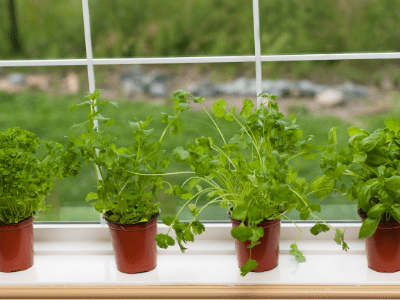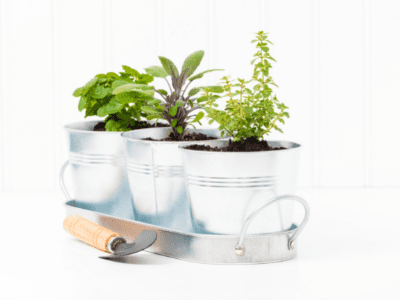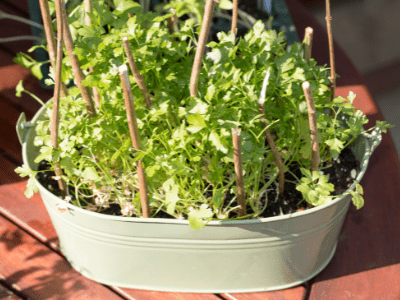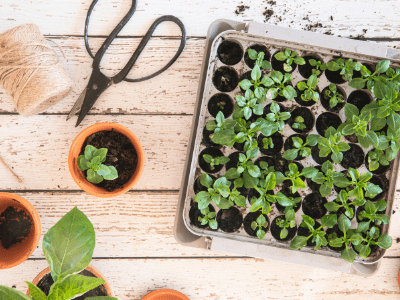Why should you grow an indoor herb garden?
There are several reasons to consider beginning an indoor herb garden, including the convenience of having fragrant herbs on hand whenever you need them and the satisfaction of knowing you cultivated them yourself.
Consider adding a sprig of rosemary to your roasted veggies, sprinkling a bit of cilantro in your homemade guacamole, or flavouring your fresh tomato sauce with a few leaves of freshly selected basil.
However, as charming as they may appear, these tiny herbs provide significant hurdles to the ambitious indoor gardener.
Most plants require at least six to eight hours of bright light every day, as well as enough water to keep their roots from rotting.
Does that sound too hard to build an indoor herb garden?
This is what Alice said about it.
When I was married to my husband in 2019, I was very worried.
No, there’s nothing wrong with his family.
But I feel like my cooking skills aren’t on par, knowing how he and his family love heavy-spiced foods.
They love good smelling herbs in their cooking and…
…that’s something pretty hard for me as I didn’t know that much about herbs.
My neighbour, however, has an indoor herb garden.
When I told her about my concerns, she was very willing to teach me about herbs!
I started growing my own indoor garden because of her.
It was easier for me to learn and now my husband and his family love my cooking even more!
Imagine how would that feel if you were in Alice’s shoes?
It’s wonderful!
Whatever’s the reason for you to have an interest in an indoor herb garden, we’ve got you covered.
Tips for Building an Indoor Herb Garden

Herbs may readily be cultivated indoors if you take the proper precautions at the start.
Understanding the needs of the plants and ensuring that they are met is the key to building a successful indoor kitchen herb garden.
That’s all there is to it.
Providing Light for Your Indoor Herb Garden
Grow lights for indoor gardening is important.
The more light you can supply, the better off your indoor herb garden will be. Did you realize that the brightness of the light affects the flavor of your herbs?
Herbs cultivated in bright light will almost always have the best flavour. Their growth is also aided by bright, intense light. One of the most critical aspects of successfully growing herbs indoors is having enough light.
Herbs require 6 to 8 hours of direct sunshine to thrive. Indoor herb garden grows best in a bright, sunny window or sunroom.
The greatest option is to have windows that face south. If the window sill is simply not large enough to comfortably fit your pots, you can install a little table directly in front of the window.
A suction cup window shelf is another option to provide a healthy growth environment for your herbs if you have a great sunny window but no space for a table.
Even if you don’t have access to a light window, you can still cultivate herbs indoors. All you have to do now is add another light source.
If you’re only cultivating one or two herb pots, cheap task light with a CFL bulb from the hardware store would suffice.
Grow light systems can be purchased from a variety of garden centres and internet sellers. They provide a variety of alternatives, from a kitchen counter setup to a wall unit where you can grow a whole herb garden.
AeroGarden has developed a variety of indoor herb garden growing systems that include an LED light system built into the herb planter.
If you’re interested in buying one, here you go.
AeroGarden Harvest – Indoor Garden with LED Grow Light
Prices pulled from the Amazon Product Advertising API on:
Product prices and availability are accurate as of the date/time indicated and are subject to change. Any price and availability information displayed on [relevant Amazon Site(s), as applicable] at the time of purchase will apply to the purchase of this product.
AeroGarden Bounty Basic – Indoor Garden with LED Grow Light
Prices pulled from the Amazon Product Advertising API on:
Product prices and availability are accurate as of the date/time indicated and are subject to change. Any price and availability information displayed on [relevant Amazon Site(s), as applicable] at the time of purchase will apply to the purchase of this product.
You can also select to plant herbs that require a little less sunlight.
Mint, parsley, and chives can withstand less than 6 hours of direct sunlight.
Keep an Eye on the Temperature

Another key component in effectively growing an indoor herb garden is temperature.
The optimal temperature for most herbs is 65 to 70 degrees Fahrenheit, which is perfect for most residential settings.
When you wish to slow down the growth of your herb plants, you might lower the temperature to 60-65 degrees Fahrenheit.
Some plants require a time of dormancy.
Plants can be stored in a cooler place if they are overwintering inside.
It may become uncomfortably cold directly next to the window in homes with drafty windows.
Insulating your windows is a simple way to solve this problem (even a towel placed between the window & screen will help).
Basil is the plant that requires the greatest attention when it comes to temperature.
Basil enjoys the warmth and would appreciate a consistent temperature of 75 degrees if at all feasible. If basil gets too cold, you’ll notice right away since the leaves begin to wilt and turn brown within 24 hours.
Slow Watering Method

Allowing the pots to dry out between waterings is crucial when watering an indoor herb garden.
Using your finger, test the dirt. It’s time to water if the soil is dry around 2 inches below the top (give or take depending on the size of the pot).
Don’t worry if it’s too dry; it won’t hurt your herbs.
Because the soil dries out from the top down, even if the top is dry, the dirt at the bottom of the pot is likely still damp.
The idea is for the roots to grow deep into the soil in search of water. This promotes a robust, healthy root system.
Another key point to remember is to water your plants gradually. Watering too soon can cause the water to rush straight through the pot and out the drainage holes before the soil has a chance to absorb it.
Indoor plants benefit from slow, thorough watering.
Make an effort to stick to a routine. Depending on the moisture level in your home, two to three times a week be sufficient.
Herbs should never be watered on a daily basis. If you find yourself needing to water on a daily basis, there are a few possibilities:
The herb plant is too little for the pot.
Remove the plant and inspect the roots. Is the root system taking up the entire pot? This is a clear indication that it’s time to upgrade to a larger pot.
It’s possible that the humidity level in your home is too low. Add a dish packed with small pebbles to the same area as your indoor herb garden.
Fill the container with just enough water to cover them. The water will evaporate around your plants, providing them with the additional moisture they require to thrive.
It is excessively hot.
The sun’s heat might cause pots to dry out more quickly. If your herbs are drooping and becoming too dry, you may want to shift them away from the window.
If you’re having trouble overwatering or underwatering your herbs, you might want to invest in a soil moisture meter.
These useful devices will keep track of how much water the soil contains and alert you when it’s time to water.
Choosing the Pot
When growing an indoor herb garden, choosing the right pots or containers is critical to your success.
Make your own pots, but make sure they include drainage holes and saucers.
Making a Drainage

The most crucial consideration is ensuring that your herb pots have adequate drainage.
Any container used to cultivate herbs inside must have sufficient drainage holes.
Because herbs dislike being maintained in standing water, there must be a mechanism for the water to drain from the pot.
TIP: Fill a container halfway with water and observe how fast or slowly the water drains from the bottom. If your herb’s roots are sitting in water, add a few pebbles to the bottom of the pot to help it drain faster. This test should be performed prior to adding soil and herbs!
Preparing Saucers
If you’re making an indoor herb garden, make sure you have a saucer for each pot.
If you don’t have a container for the water to drain into, you might quickly ruin a table or cause a mess.
A saucer or other complementing pieces are included with several pots.
Plastic plant saucers are also available for less than a dollar in most hardware shops’ gardening sections.
Alternatively, if you have a decorative tray, that will suffice.
Pot Size
The second most crucial factor to consider when choosing the right pot for your indoor herb garden is choosing pots that are the right size for the herb you’re growing.
Basil, for example, has longer roots and will benefit from a larger container. It will be more difficult to keep the soil evenly moist if you buy a pot that is too large.
Your herb’s growth may be inhibited if the pot is too small for it.
Pot Materials

Choose an indoor herb pot based on your home’s humidity level. The sort of pot you choose can affect the amount of moisture in the room.
Ceramic pots will keep water in, however, clay pots would dry up faster. Use a ceramic pot instead of clay or porous pots if your area is dry.
Sum Up
All in all,
When you know what to do, growing Indoor Herb Garden isn’t as hard as you imagine.
Plants are great but it can be better when you can consume them.
Not only they’re pretty, they’re also edible.
Great idea, isn’t it?
Conclusion
What do you think?
If you have any doubts and questions about growing your Indoor Herb Garden…
…drop us a comment down below!
We’ll get to you as soon as possible!




